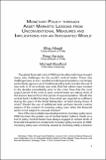Artículo
Monetary policy thorugh asset markets: lessons from unconventional measures and implications for an integrated world
Date
2016Abstract
The global financial crisis of 2008 and its aftermath have brought many new challenges for the world’s central banks. These new challenges have in turn resulted in bold experimentation—not simply particularly vigorous use of traditional policy tools but also the use of new tools or if not entirely new tools that had seldom been invoked in the decades immediately prior to the crisis. Now that the most urgent period of the crisis is past central banks are taking stock of the lessons learned from this period of experimentation. Should the central bank’s toolkit be larger than what was regarded as sufficient during the years of the Great Moderation at least during times of crisis? Should the use of additional tools perhaps become routine aspects of the conduct of monetary policy even when the financial sector is not subject to unusual stresses?
Collections
View/


